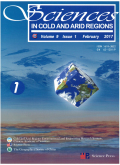- 钛学术文献服务平台 \
- 学术期刊 \
- 基础科学期刊 \
- 天文学、地球科学期刊 \
- 寒旱区科学(英文版)期刊 \
null
Validation of AIRS-Retrieved atmospheric temperature data over the Taklimakan Desert
基本信息来源于合作网站,原文需代理用户跳转至来源网站获取
摘要:
The Taklimakan Desert, the world's second largest desert, plays an important role in regional climate change. Previous studies on its spatial temperature features suffered from sparse conventional detection data, but the Atmospheric Infrared Sounder (AIRS) provides excellent temperature retrievals with high spatiotemporal resolution. Validation of AIRS temper-ature retrievals over desert regions with high land-surface emissivity, the key contributor to inversion error, is essential be-fore using these data in regional weather/climate modeling. This paper examines the correlation coefficients, root mean square error (RMSE) and mean BIAS between AIRS-retrieved atmospheric temperature data and radiosonde observations (RAOBs) in the Taklimakan Desert hinterland and oases in the morning and at dusk. Firstly, the AIRS retrievals are consis-tent with RAOBs and are more consistent in the morning than at dusk. The consistency is better over a small-scale desert oa-sis than over a large-scale oasis in the morning and exhibits the opposite trend at dusk. The correlation coefficient over the hinterland is high in the morning but negative at dusk due to high desert-surface emissivity. Second, the RMSEs, which are all smaller than 3 K, are generally higher over desert sites than over oasis sites and slightly lower over a small-scale oasis than over a large-scale oasis in the morning. At dusk, the RMSEs are higher over desert sites than over oases and slightly higher over a small-scale oasis than over a large-scale oasis. Furthermore, the RMSEs are generally higher in the morning than at dusk over a large-scale oasis and lower in the morning than at dusk over a small-scale oasis. Third, the absolute mean BIAS values are mostly lower than 1 K. In the morning, relative to RAOB temperatures, the retrieval temperatures are higher over desert sites but lower over oasis sites. At dusk, the retrieval temperatures are lower than RAOB tempera-tures over both desert and oasis sites. The retrieval temperatures are higher than RAOB temperatures over desert sites in the morning but slightly lower at dusk. Most absolute mean BIAS values are higher in the morning than at dusk over both oasis and desert sites. Finally, the consistency between the AIRS and RAOB temperature data is high from 700 hPa to 100 hPa in the morning and from 700 hPa to 300 hPa at dusk. The difference between the AIRS and RAOB temperature data is generally higher in the morning than that at dusk. The RMSE differences between the AIRS and RAOB data are slightly lower in the morning than at dusk and are lower in the middle layers between 700 hPa and 150 hPa than in the lay-ers above 150 hPa during both the morning and night. The BIAS is lower in the morning than at dusk below 300 hPa but higher in the upper layers. Moreover, the BIAS value is positive in the middle layers between 500 hPa and 150 hPa and negative at other levels at both times. Generally, the AIRS retrieval temperatures are reliable and can be used in fur-ther studies in the Taklimakan Desert.

推荐文章
期刊_丙丁烷TDLAS测量系统的吸收峰自动检测
带间级联激光器
调谐半导体激光吸收光谱
雾剂检漏 中红外吸收峰 洛伦兹光谱线型
不同盐度、温度及光照对漂浮浒苔生理生态的影响
浒苔
盐度
温度
光照
生理生态
期刊_联合空间信息的改进低秩稀疏矩阵分解的高光谱异常目标检测
高光谱图像
异常目标检测 低秩稀疏矩阵分解 稀疏矩阵 残差矩阵
内容分析
关键词云
关键词热度
相关文献总数
(/次)
(/年)
文献信息
| 篇名 | Validation of AIRS-Retrieved atmospheric temperature data over the Taklimakan Desert | ||
| 来源期刊 | 寒旱区科学(英文版) | 学科 | |
| 关键词 | |||
| 年,卷(期) | 2020,(4) | 所属期刊栏目 | |
| 研究方向 | 页码范围 | 242-251 | |
| 页数 | 10页 | 分类号 | |
| 字数 | 语种 | 英文 | |
| DOI | |||
五维指标
引文网络
引文网络
二级参考文献 (76)
共引文献 (42)
参考文献 (14)
节点文献
引证文献 (0)
同被引文献 (0)
二级引证文献 (0)
1957(1)
- 参考文献(0)
- 二级参考文献(1)
1970(1)
- 参考文献(0)
- 二级参考文献(1)
1973(1)
- 参考文献(0)
- 二级参考文献(1)
1975(1)
- 参考文献(0)
- 二级参考文献(1)
1979(1)
- 参考文献(0)
- 二级参考文献(1)
1980(1)
- 参考文献(0)
- 二级参考文献(1)
1982(1)
- 参考文献(0)
- 二级参考文献(1)
1983(1)
- 参考文献(0)
- 二级参考文献(1)
1985(1)
- 参考文献(0)
- 二级参考文献(1)
1986(2)
- 参考文献(0)
- 二级参考文献(2)
1988(2)
- 参考文献(0)
- 二级参考文献(2)
1989(1)
- 参考文献(0)
- 二级参考文献(1)
1991(1)
- 参考文献(0)
- 二级参考文献(1)
1993(1)
- 参考文献(0)
- 二级参考文献(1)
1994(3)
- 参考文献(0)
- 二级参考文献(3)
1995(1)
- 参考文献(0)
- 二级参考文献(1)
1996(2)
- 参考文献(1)
- 二级参考文献(1)
1998(3)
- 参考文献(0)
- 二级参考文献(3)
1999(2)
- 参考文献(0)
- 二级参考文献(2)
2000(4)
- 参考文献(0)
- 二级参考文献(4)
2001(3)
- 参考文献(0)
- 二级参考文献(3)
2002(2)
- 参考文献(0)
- 二级参考文献(2)
2003(5)
- 参考文献(3)
- 二级参考文献(2)
2004(2)
- 参考文献(1)
- 二级参考文献(1)
2005(6)
- 参考文献(0)
- 二级参考文献(6)
2006(10)
- 参考文献(0)
- 二级参考文献(10)
2007(4)
- 参考文献(0)
- 二级参考文献(4)
2008(8)
- 参考文献(4)
- 二级参考文献(4)
2009(1)
- 参考文献(0)
- 二级参考文献(1)
2010(8)
- 参考文献(1)
- 二级参考文献(7)
2011(1)
- 参考文献(0)
- 二级参考文献(1)
2012(2)
- 参考文献(0)
- 二级参考文献(2)
2013(2)
- 参考文献(1)
- 二级参考文献(1)
2014(3)
- 参考文献(1)
- 二级参考文献(2)
2016(1)
- 参考文献(1)
- 二级参考文献(0)
2017(1)
- 参考文献(1)
- 二级参考文献(0)
2020(0)
- 参考文献(0)
- 二级参考文献(0)
- 引证文献(0)
- 二级引证文献(0)
引文网络交叉学科
相关学者/机构
期刊影响力
寒旱区科学(英文版)
主办单位:
中国科学院寒区旱区环境与工程研究所
科学出版社有限责任公司
出版周期:
双月刊
ISSN:
1674-3822
CN:
62-1201/P
开本:
出版地:
甘肃省兰州市东岗西路320号
邮发代号:
创刊时间:
语种:
eng
出版文献量(篇)
870
总下载数(次)
0
总被引数(次)
1072
期刊文献
相关文献
推荐文献
- 期刊分类
- 期刊(年)
- 期刊(期)
- 期刊推荐
力学
化学
地球物理学
地质学
基础科学综合
大学学报
天文学
天文学、地球科学
数学
气象学
海洋学
物理学
生物学
生物科学
自然地理学和测绘学
自然科学总论
自然科学理论与方法
资源科学
非线性科学与系统科学
寒旱区科学(英文版)2022
寒旱区科学(英文版)2021
寒旱区科学(英文版)2020
寒旱区科学(英文版)2019
寒旱区科学(英文版)2018
寒旱区科学(英文版)2017
寒旱区科学(英文版)2016
寒旱区科学(英文版)2015
寒旱区科学(英文版)2014
寒旱区科学(英文版)2013
寒旱区科学(英文版)2012
寒旱区科学(英文版)2011
寒旱区科学(英文版)2010
寒旱区科学(英文版)2009
寒旱区科学(英文版)2008
寒旱区科学(英文版)2020年第6期
寒旱区科学(英文版)2020年第5期
寒旱区科学(英文版)2020年第4期
寒旱区科学(英文版)2020年第3期
寒旱区科学(英文版)2020年第2期
寒旱区科学(英文版)2020年第1期

 免费查重
免费查重










